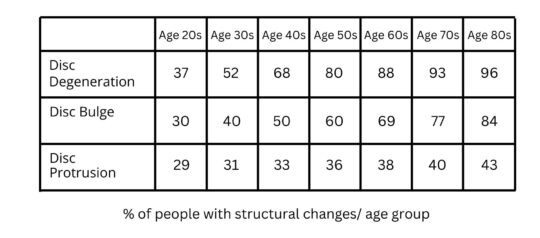Scans, e.g., Xrays & MRI, may or may not find a perfect, physical body. But either way, it might not reveal the source of pain. Yes, it’s complicated! Here’s why…
Scans usually show many things, e.g., bone fractures, significant muscle/ligament/cartilage tears, inflammation, so they should reveal many problems. BUT…
1. Even if it shows a ‘non-perfect’ physical form, research tells us that damage does not equal pain.
For example:
One review pooled together all the credible back scan studies of people without pain = 3,110 people (Brinjikji, et al., 2015). The table shows that for every kind of image finding, a reasonable % of every age group had it and that the % increased with age.

So, what does this tell us? Just that our body can change at any age and that it is a natural part of ageing: However, the body change itself does not lead to pain. None of these people would have known about their ‘non-perfect’ body without the scan: They could have had it without pain for years. But of course, if at some point they had pain, a scan would show it!
2. Conversely, those with no/little physical damage can experience agonising pain, particularly those with chronic pain (3 months+).
For example, Achilles’ Tendinopathy research revealed those with the worst pain-related symptoms and lowest quality of life had minimal changes to their Achilles’ structure: In fact, their Achilles’ structure was very similar to the ‘activity-dominant’ subgroup who had the highest level of function and quality of life (Hanlon, et al., 2021).
So, What’s Going On?
We have pain when our brain thinks we’re in danger. To protect us, it increases our nerve sensitivity and immune response.
What makes the brain decide danger or safety? Many things, our beliefs, thoughts, emotions, … For example, the group with the worst symptoms in the above Achilles research had the most negative thoughts about their injury and the highest fear of moving.
Then alas, particularly when we have chronic pain, our brain becomes super-efficient at deciding ‘Danger!’ and creating protective pain – even if there’s no physical concern.
Of course, the irony is that seeing a ‘non-perfect’ body on a scan can set off the protective, pain-producing, danger bells. As can hearing, ‘You’ve got a … (e.g., ‘slipped disc’)!
What Should I Do?
Always ask a trusted healthcare professional to check for physical causes. BUT relying on finding a treatable, physical cause can be confusing and stressful – emotions that ramp up the pain.
So regardless of what the camera says, learn more about pain. Pay attention – what brings pain on or reduces it? Are you afraid to move? Do you have many negative thoughts? These are clues of how to reduce pain. Of course, we can help you with this.
References
- Brinjikji, W, et al. (2015), Systematic Literature Review of Imaging Features of Spinal Degeneration in Asymptomatic Populations. American Journal of Neuroradiology, 36, 811-16.
- Hanlon, S. L., et al. (2021). Beyond the Diagnosis: Using Patient Characteristics and Domains of Tendon Health to Identify Latent Subgroups of Achilles Tendinopathy. Journal of Orthopaedic Sports Physical Therapy, 51(9): 440-448.
